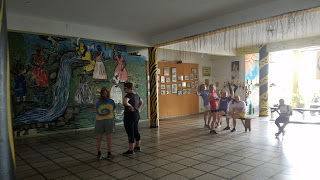April 30
On the 30 we all had two different classes to attend; one was Capoeira and the other was a percussion class. To start our day we all dress in athletic clothes as we set off to attend our Capoeira private lesson. Capoeira is a style of dancing that looks like fighting created by the slaves and was illegal until the 1930s. There were two different styles of the Capoeira and we we fortunate enough to learn the basic beat, song, and the basic moves for the modernized version with the fighting on your feet. This dance is a form of exercise and communication that teaches discipline to all the students of the dance today. Social projects use it as an inexpensive art and sport to keep kids occupied the other half of the day when they are not in school. The master is a father like figure to the students and it allows them to have somebody to look up too. This dance allows you to control your angry and if needed show somebody you can hurt them but never actually hurt them unless you are in danger. Each and everyone of us took to the center of the circle at the end of class to show the moves we had learned with one of the instructors. Capoeira is known and done in over 170 countries and has seven different studios by this company in the United States. People in the town on Salvador practice their skill from 12-2 or during there lunch break and can be heard while walking on the streets in the old city. After getting all sweaty we thanked our teachers and headed to lunch.
Lunch was at a restaurant in the old city called Mama Bahia. We sat outside under an umbrella despite the rain and enjoyed the live music coming from inside. We all ordered ahead and almost everyone asked for the shrimp which came in a pineapple. For dessert we had a choice of passion fruit or chocolate mousse and black and white coconut.
From here we made it down to our next class which was percussion. This particular percussion is the famous Afro-Brazilian drumming and is known for their movement to bring females into drumming. Traditionally this music was played by all men but in 1993 that all changed due to Banda Didá. One of the main faces of this group have us out lesson, Viviam Caroline de Jesus Queirós. She was once affiliated with the leader of the band that starred in Paul Simmon’s “The Obvious Child”. We learned three of the basic beats and had fun listening to the rhythm that was able to break gender boundries in the very room those women learned the same beats. It was inspiring to be taught be one of the women who paved the way for so many others to learn the rhythm and beats.
From here we traveled to the Church and Convent of Saint Francis. As we walked in to the church in what they call the cloister the walls were tiled with stories and titles “The Moral Theatre of Human Life” and were inspired by painting of a Flemish artist Oto Van Veen. As we walked into the church we could see why they refer to this as the wealthiest church. Every inch sparkles with gold of had a beautiful sculpture. Sculpted in 1702, the gold leaf was donated by the rich and then there tombs were paid for in the cemetery located on the grounds. They used a style known as Baron but is commonly referred to as colonial style. They use the contrast of light and dark that allowed you to notice something new at different times of the day and made other things stand out more at other times of the day. The Church took around soxty years to construct and was floored with Thick slabs of marble. The furniture was crafted and carved from rosewood and everything looked marvelous. Everything within the Church was not randomly placed or carved but has a deep underlying symbol. A convent that use to hold around 200 monks is now home to around 22 as the times and traditions change people come to be monks only if they want to not due to the birth order within a family.
Today I was able to learn two different musics and see how both are equally important to the history of the Brazilian people wether it was a means of communication for the slaves or a breakthrough in a gender stereo type both allowed me to learn and explore the culture in new ways.



Comments
Post a Comment